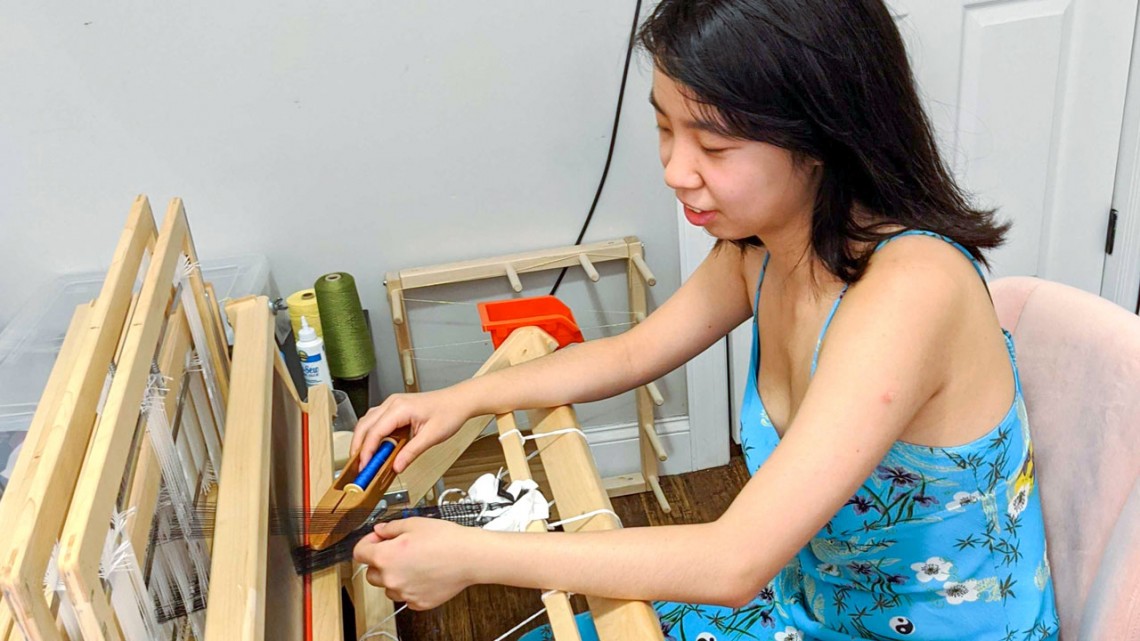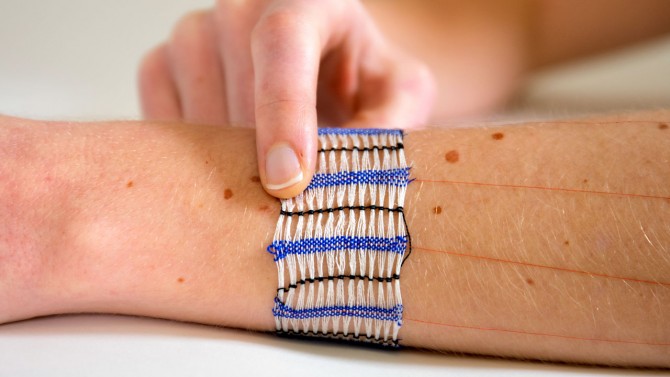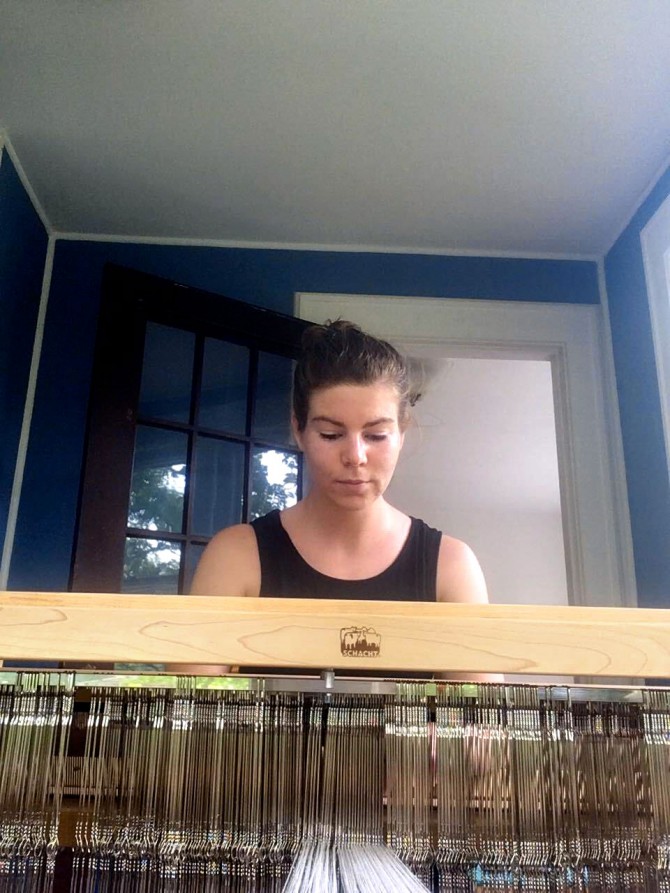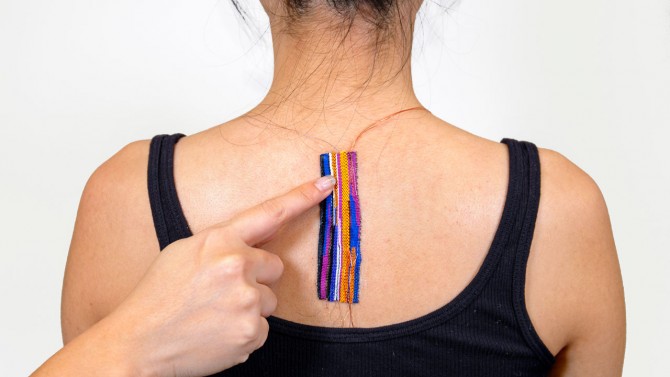
Ruojia Sun ’20, a mechanical and aerospace engineering major, is one of several of Cindy Kao’s students in the Hybrid Body Lab who brought home a loom to continue her experiments with weaving during the pandemic.
Kao weaves craft techniques with on-skin tech
By E.C. Barrett
What if your clothing expressed your personality or culture – and could communicate with your cellphone or smart home?
New research led by Cindy (Hsin-Liu) Kao, assistant professor of Design + Environmental Analysis (DEA) and director of Cornell’s Hybrid Body Lab, pairs centuries-old craft techniques with cutting-edge technology to advance the research, design and fabrication of on-skin interfaces.
The research was presented at the Association of Computing Machinery Designing Interactive Systems Conference, held virtually July 8-10. The paper, “Weaving a Second Skin: Exploring Opportunities for Crafting On-Skin Interfaces Through Weaving,” earned honorable mention for best paper, as well as the best demo award at the conference.
“Our paper introduces this new design space that offers any engineer, designer or maker a way to create on-skin interfaces through weaving,” Kao said. “I think the community is really excited at the possibility of bridging this craft that has so much legacy and artistic quality with these new wearable devices.”
Advances in wearable technology have largely been made by engineers in advanced labs, Kao said, with scant focus on aesthetics, cultural relevance or individual expressiveness. They are most often fabricated with specialized clean-room processes or digital technologies such as laser-cutting and 3D printing and tend to look like circuitry – what Kao called a “nerd aesthetic.”
In 2018, Kao visited a weaving workshop in Kyoto, Japan, that has been in operation for 1,000 years and is now in its 16th generation of weavers.
“I was stunned by the skill and the craft involved,” she said. “I started thinking about the craft of different cultures and how we could bring that craft and expressiveness to these on-skin interfaces.”
Kao invited textile artists from Luna Fiber Studio in Trumansburg, New York, into the lab to weave their own on-skin interfaces using the WovenSkin fabrication process developed by Kao and the undergraduate and graduate students from DEA, fiber science and apparel design (FSAD) and mechanical engineering who work in her lab.
The weavers chose the interface functions and which patterns to create. One weaver, for example, wanted a touch sensor worn over the heart that would send a text message to a loved one when she touched it. Using a weave pattern she selected for aesthetics and for material functionality, she wove conductive wires that were connected to a circuit, which controlled a Bluetooth unit.
The collaboration, an example of a research-through-design approach that creates prototypes to investigate a design, yielded unique, functional interfaces, as well as insights into what craftspeople can teach experts in STEM about designing with textiles.
“We quickly saw the importance of working by hand,” Kao said. “In computer science and engineering there’s this fascination with automating everything, but it was an important part of the process for these weavers to feel the texture and improvise with how it would work. That’s hard to distill from an engineering perspective, but is really valuable for figuring out how to integrate these technologies with textiles.”
Including craftspeople in the research was so successful that Kao decided for her next project she would work with a textile artist from the start. She teamed up with Melissa Conroy, senior lecturer in FSAD and an expert knitter, and they brainstormed turning the inherent stretchability of knit textiles into self-stiffening protective gear for high-impact activities and braces for injury recovery.
“Let’s say you had surgery on your lower hip and you’re sitting in a certain posture that might hurt you; this skin layer could stiffen and provide feedback,” Kao explained.
Kao and Conroy recently received a grant from the Center for Craft to develop these knitted interfaces. They will be purchasing hand-knitting machines to continue their research at home during social isolation, just as Kao’s students in the Hybrid Body Lab have brought home looms to continue their experiments with weaving. She said the ability to work on these interfaces at home highlights another benefit of craft over specialized clean-room processes, which require labs that are currently shut down.
“Right now, we’re creating fabrication processes. The next step is creating toolkits that are more scaffolded so that an elementary school student could quickly prototype an interactive temporary tattoo by sticking a couple of modules together,” Kao said.
“My long-term goal is to think about how we can democratize on-skin interfaces, so that anyone can make them and decide what they look like,” she said, “rather than a few people in Silicon Valley or in advanced labs deciding our future. Engaging craftspeople is the first step of that.”
Students Ruojia Sun ’20 (Mechanical and Aerospace Engineering), visiting researcher Ryosuke Onose (D+EA), Margaret Dunne ‘20 (FSAD), Andrea Ling ’20 (D+EA) and Amanda Denham ’17 (FSAD) co-authored the WovenSkin research paper.
The project is supported in part by a President’s Council of Cornell Women Affinito-Stewart Grant.
E.C. Barrett is a freelance writer for the College of Human Ecology.
Media Contact
Get Cornell news delivered right to your inbox.
Subscribe



